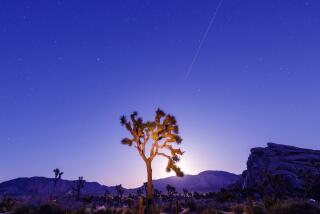Did volcanoes erupt on the moon while dinosaurs roamed Earth?
Ever looked up into the night sky and seen the ancient face of the “man on the moon”? Well, turns out he may have had some recent work done.
Scientists thought the moon has been cold and dead for roughly a billion years. But strange small features on the surface discovered by NASA’s Lunar Reconnaissance Orbiter reveal that there could have been volcanic activity during the time of the dinosaurs. That’s practically just last week, by geological timescales.
The findings, described in the journal Nature Geoscience, could force researchers to reconsider established theories on the moon’s evolution.
The large dark patches on the lunar surface that give shape to the moon’s “face” are called maria, and they’re thought to be the remains of volcanic activity on the moon that started 3.5 billion years ago. Scientists thought the moon cooled quickly, and this period of volcanism ended abruptly, around a billion years back.
There were some anomalies – for example a strange feature called Ina, imaged from orbit by Apollo 15 astronauts in 1971, that seemed to be very young. But Ina was thought to be an exception, and it wasn’t clear what its existence meant.
Now, using the NASA orbiter, a team led by Arizona State University scientists picked out 70 of these strange features – round, smooth areas, surrounded by rough, choppy terrain. They’re called “irregular mare patches,” and they’re too small to be distinguished with the naked eye from Earth. Though they range in size from 328 feet to 3.1 miles, the average is 1,591 feet, or 0.3 miles.
Since the scientists have no way to bring this rock back to the lab to study, they relied on a commonly used method to date these strange features. Essentially, the more craters that pock their surfaces, the older they are (because older features have had more time to be smashed by space debris). These crater counts have been calibrated using the laboratory-measured ages of moon rock samples brought back by Apollo astronauts.
The researchers found that scores of these features were less than 100 million years old – which would put them in range of the Cretaceous period on Earth, which was the dinosaurs’ heyday. Some were even younger – Ina could be 33 million years old and another patch, Sosigenes, could be just 18 million years old.
That means there could have been regular volcanic activity all around the moon in very recent times – not like the dramatic volcanism that produced the enormous maria, but still significant and widespread. It also means that the moon cooled more gradually than scientists thought, and that we may not really understand how much heat still remains inside of it. Theories about the moon’s thermal evolution might need a serious rethink.
The best way to know for sure? Return to the lunar surface and bring back rock samples that can be analyzed in the lab, the authors say. (The last time that happened was in the 1970s.)
“Sample return will be required for radiometric age dating to confirm the relatively young ages implied by remote sensing observations,” the study authors wrote.
Loony for the moon? Follow @aminawrite for more fascinating science news.







